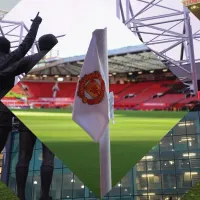the Gaffer’s suggestion for articles
Football is the Beautiful game, just watch Berbatov’s second at the weekend for an example. However the aesthetic beauty is underlined by the strategic theme running through the game throughout. In Football, Managers are the top authority at a football club on a day-to-day basis and very rarely are results blamed on the coaching staff or the Chairman. One of the key tasks of the football manager is to select the tactics heading into each encounter. Here i will run down the choices that lie before him, the strengths and weaknesses of a formation so the next time you settle down for a match and see the teams line up you can confidently point out how you expect the match to fare.
NB: This is a long one folks.
First and foremost how do you read tactics, well you read them from the back forwards. That is to say a 4-4-2 has 4 men in defence 2 men in the centre 2 men at the sides. The same goes for the midfield and ‘up front’ are the 2 strikers. If we were to complicate it slightly a 4-1-4-1 would indicate that a striker has been sacrificed for a player between the midfield and defence. Though this would often just be referred to as a 4-5-1 but it gets you thinking about where the players are on the pitch.
Noted tactical writer Jonathan Wilson once said:
“The history of tactics is the history of the manipulation of space”
It is that key word, ‘space’, that relates to football. With the ball at his feet in space most football players will be a danger to the opposition be it a winger with the time to pick out that inch perfect cross (David Beckham), or be it the creative midfielder who only needs one pass to decimate a defence (Xavi or Xabi your choice) or even dare you let a striker turn into space and run at a defence (Drogba). Tactics are chosen to prevent and create those opportunities, here is an (incomplete) list of the main categories.
4 Man Defences:
4-4-2: The missionary position of Football, the 4-4-2 has been around for a very long time. The key thing it brings is stability, a 4-4-2 is reliable in that you can cover the entire pitch twice. Centre backs are comfortably paired beside each other without having to drift out to each wing or to midfield unless in an emergency. The wingers have a defined role to take on the opposition full back and to follow him when he goes forward, for the full back the inverse applies. When two teams line up in a 4-4-2 the game is usually decided by who has the better players, space can be created between the two lines the 4 and the 4 for a midfielder to drift into and pick out one of his forwards or a winger to beat his man and deliver the devastating cross to either of the two strikers. The problem with 4-4-2 is it’s history, Managers have had years to work around it and it is by no means the dominant formation it once was. England have been criticised for their reliance on the 4-4-2 as most of their continental brethren have more ‘sophisticated’ systems (See Tottenham’s destruction in the first half in Switzerland). However a well implemented 4-4-2 can still be the most effective tactic on the given day (see England’s destruction of Bulgaria then Switzerland themselves).
4-5-1: The most prevalent defensive formation. The 4-5-1 is built around the idea that if you have a large amount of players in midfield you can stop the opposition playing and it often works. By clogging up the middle of the park with players the ability for the more creative or pacey players to find space is hampered. In these situations the team is trying to not lose, by staying organised (ie not leaving your position) you can frustrate even the very best team and if you get a few chances on a counter attack – getting the ball forward quickly as the other team is out of position – you may even steal a victory. It is the seal of a quality manager if he can work his team around this formation to pick up wins regardless of this tactic, something Rafa Benitez failed to do.
4-3-3: Ostensibly a more attacking formation you remove one man from Midfield to add to the strikers. However in reality it often works out that you have 3 players in central midfield one striker and 2 wingers. Technically you have 5 players in midfield but this is not to be confused with the 4-5-1. 4-3-3 and it’s variations are the tactic de jour. Seeing one striker toil away against two defenders has seen striker’s goals declining but an increase in goals scored by the wingers who leave their wing and move inside, that is towards goal rather than the corner flag, where they hope to get a shot away. The key proponent of this role is Leo Messi. He plays on the right of Barcelona’s front ‘three’ but as a left-footed player he moves towards goal on his stronger foot. An example of a modern 4-3-3 is Blackpool’s formation last year and this, apparently based on an Italian team Foggia’s rise in the early nineties who also depended on attacking to keep the opposition off balance.
The 4-3-3 also provides flexibility as you can change your roles easier when you are not in possession. Under Jose Mourinho when Chelsea lost the ball their ‘wingers’ would come back alongside their central midfielders and create the 4-5-1 mentioned above. This allowed Chelsea to be both attacking and extremely defensive but required a lot of their wingers.
The next tactic (though it looks complicated) is just a variation on this theme.
4-2-3-1: The main tactic played by elite football teams at both club and international level. This formation is at it’s core a variation on a 4-3-3. The 2 are two defensive midfielders the 3 are the wingers – who come inside like above – and an attacking midfielder who is freed from the defensive duty a 4-4-2 or 4-3-3 imposes on him. Think Wesley Sneijder for Inter or Mesut Ozil for Germany when you think of this player. The problem is that when this formation meets another the game can get narrow as no team has true width and the left and right backs cannot go forward as they are met with the two wingers on each side of the -3- in that formation. This has led increasingly to left and right backs who are now just converted centre-backs. However against the 4-4-2 this formation is a killer. The attacking midfielder is free to range between the two lines of 4 and the opposition is nullified in attack by the two defensive midfielders. If a midfielder is brought back to cover the attacking midfielder this creates space for one of the two defensive midfielders to influence the game. Currently Chelsea at full-strength or Barcelona are the best at this style of play. Xavi and Iniesta are more skilful but Essien and Lampard are more powerful it would be quite the clash if these teams met at full strength in Europe this year.
3 Men Defences:
As mentioned on this blog not long ago the 3 man defence is something rarely seen these days. It was a useful tactic in the late seventies and early eighties but has died out recently bar the few teams who had the specialist players necessary to make it work (Cafu).
3-5-2 – Whilst it is written like that the tactic is actually 3 centre halves two ‘wing-backs’ who sit between defense and midfield and 3 centre midfielders. The key to this tactic are those ‘wing-backs’ the only players who give natural width to the team. This tactic required these players to attack and defend which often meant running the length of the pitch in both directions in quick succession. It is due to the scarcity of those sorts of players in today’s quicker game that these formations have died out. Last used successfully by Roma under Capello and Celtic under Martin O’Neill, an attempt to use the same formation when he returned to England did not work out. Players with the engine’s of Ashley Cole and Gareth Bale may be able to make this formation work once more but it would be a risky move to try and revitalise this one.
3-4-3 – This is a very attacking formation as the midfield already has natural width meaning that the 3 at the top is actually 3 strikers. It is very rare to see this formation but a variation on it was evident when Chile played at the World Cup. Chile were one of the most exciting teams at the tournament as their formation meant that they were consistently overnumbering their opposition in their half. This made it very difficult for teams to build attacks as they were constantly under pressure. If it were not for their wastefulness Chile would’ve garnered more attention in their opening game against Honduras. It was unfortunate that they met Brazil first in the kncok-out rounds but their insistance on attacking football was admirable.
5 Men Defences:
5-4-1: The ultimate in defensive football, recently displayed by Rangers at Old Trafford. When the teams were displayed it was obvious how this game was going to go. Rarely used in modern football except in a game where you want to keep the score respectable or are playing for the draw.
I hope the above has been useful to you as a new football fan, as an old hand it may be a bit rudamentary. However if this has wheted your appetite to discover more about tactics better writers than me are covering it in great detail. The always excellent Zonal Marking will break down interesting games from over the weekend to show how a single player or change can influence the game, similarly if the game was a bore you can see why. If you are so disposed that you want to read an entire book about football, Jonathan Wilson’s “Inverting the Pyramid” is the bible of modern football tactics.
Finally, it is important to understand that tactics are not everything sometimes it takes a Berbatov or Ben Arfa strike to determine a game. Though don’t discount it either, Jose Mourinho didn’t get to where he was based on “always” having the best players at his disposal: his success at Porto was based on defence. Mourinho has usually bought the players to suit his system and not the other way around, Inters unbelievable display at the Camp Nou after Busquets’ cheating will go down in History as one of the greatest losses in Inter Milan’s history. Aesthically it was horrible as Inter kicked the ball away with no intent to play but tactically? It was beautiful.
NB: If there is the appetite for it I could expand on most of the above. Just use the comments section below.












